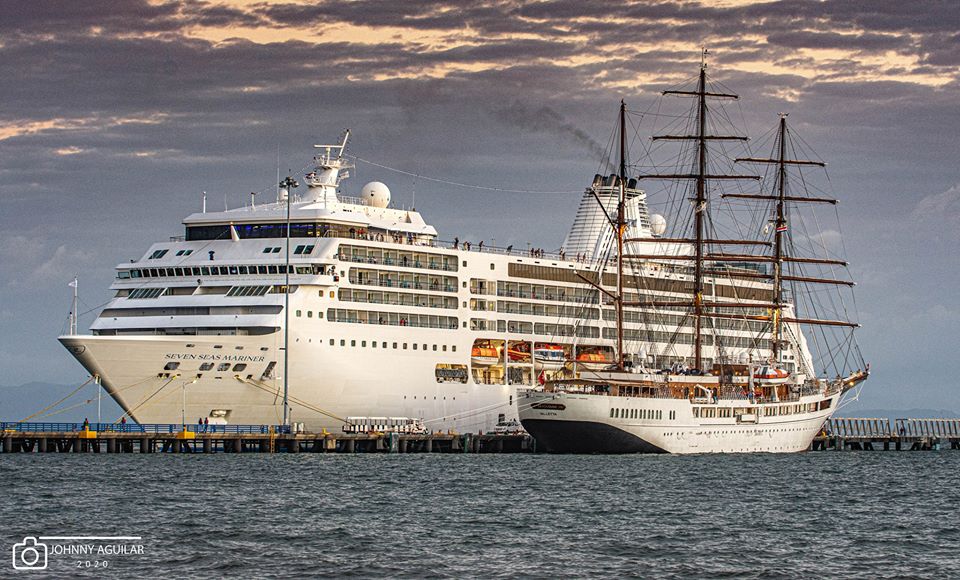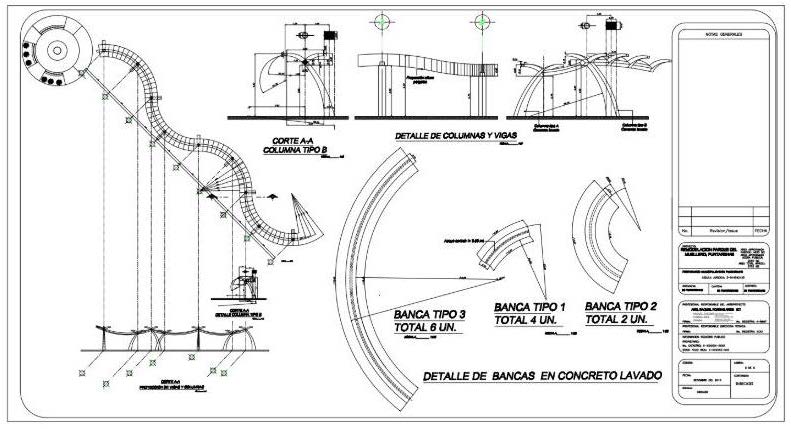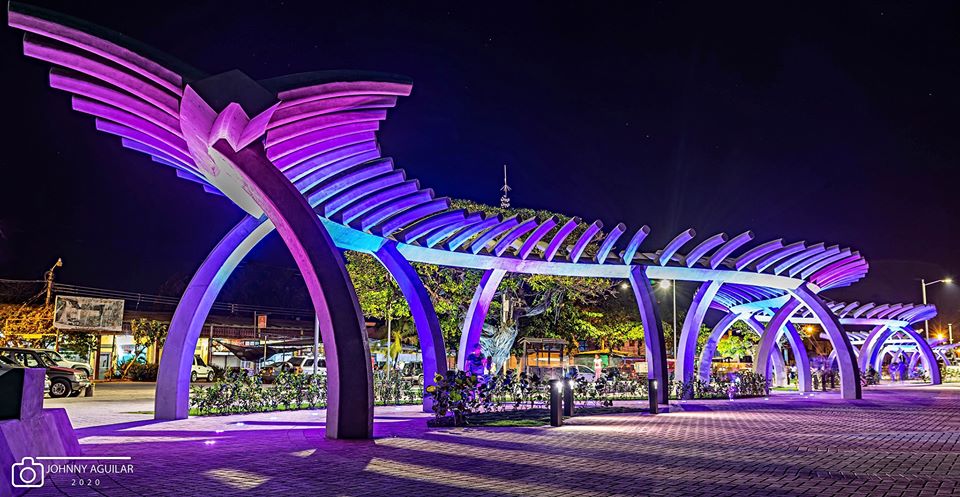In Puntarenas, located on the Pacific Ocean coast of Costa Rica, an outstanding urban infrastructure project was recently inaugurated: the “Parque del Muellero”. It was built to strengthen the development of the city’s waterfront, and to link the cruise industry and local culture with recreation, commerce, and daily life in nearby neighborhoods. However, despite the fact that the work have not been used enough, due to the crisis generated by COVID-19, it is hoped that once the pandemic is over, the cruise industry will resume and the local economy will be activated.
Cruise and sailboat in the port of Puntarenas. (© Johnny Aguilar, 2020).
Puntarenas, has long kept human development indicators low. In the last two years it has been worse with the growth of unemployment nationwide. Despite this, a good part of its economy remained afloat, thanks to tourism and the cruise industry.
On March 6, the first case of COVID-19 was identified in Costa Rica. It was a couple of American tourists who entered the country without symptoms on March 1, and in a short time they visited different parts of the country.
The health authorities took the corresponding measures to avoid the spread of contagion, collaterally affecting some activities of interest for people in Puntarenas: concerts, surf tournaments and other actions that usually attract national tourism were suspended. For everyone, the recommendation was, stay home!
At the same time, the cruise industry was paralyzed. Since March 12, no cruise ship touched the port of Puntarenas. The corona-virus crisis has hit this industry in general hard. For instance, since the start of the pandemic, the three major cruise operators (Carnival, Royal Caribbean Cruises and Norwegian Cruise Lines) lost, in less than 2 months, more than half of their market value: approximately 42,000 million of dollars. That crisis came just when they were already made most bookings for the year.
Contrary to the above, in the last six years, the cruise industry had shown extraordinary growth, and it was projected during this year 2020, about 32 million passengers. This is the reason why the construction of 19 new ships had been scheduled, with which a total of 278 cruises would be reached registered as members of the CLIA (Cruise Lines International Association).
Although not everything is positive in the cruise industry, without a doubt, it helps a lot in the generation of worldwide jobs, since it generates 1.2 million jobs and approximately 50.3 million dollars in wages.
Now, the social landscape of the city of Puntarenas is worrying, with the closing of cruise operations, hotels and restaurants; not only they are direct jobs lost, but it affects a large number of indirect jobs and sectors found in value chains, such as artisanal fishermen, transporters, tour operators, ship supply companies and even the Red Cross, which has ceased to provide services to cruise ships.
In 23 days of the presence of the COVID-19 in Costa Rica, we went from 1 to 300 cases, and the health authorities project that the great peak will arrive in early May.
This situation heralds a deepening of poverty in the province, but particularly in some neighborhoods in the central canton of Puntarenas. Undoubtedly, great efforts will be required to give these communities stability and also access to the new care conditions in bio-security. Much institutional and non-governmental organization support will be required.
Locally companies have implemented protection protocols for their employees against COVID-19, but unfortunately many of these workers, when they arrive home, in their families do not have the conditions and habits of protection expected. Having clear and correct information and respecting the new social codes will be the key to overcoming the crisis.
The good news is that until now only two cases of contagion have been reported in the entire province of Puntarenas. Trying to be optimistic, and assuming that the crisis will be overcome, and cruise operations and activities related to the tourism industry will resume, we see a Puntarenas very well prepared.
This is the case of the “Parque del Muellero”, which is seen as a promise to re-link the port with the city, but its proper functioning will depend on the existence of a strategic plan that projects impacts at the urban and economic level. It is a project that is inspired by “El Palmeral de las Sorpresas” at the cruise terminal in the city of Malaga, in Spain.
The idea arose in 2012, when I participated in an activity organized by RETE at the OMAU (Observatorio de Medio Ambiente Urbano – Málaga). It was on that occasion that I met the architect Jerónimo Junquera, “Palmeral de las Sorpresas” designer, and invited him to visit Costa Rica. In just a few months we had several initiatives presented for a project in the Caribbean called Limón Ciudad-Puerto, which unfortunately had a technical closure, and we were unable to develop any of these initiatives.
However, in 2016, by appointment of the President of the Republic, Luis Guillermo Solís Rivera, it was my responsibility to assume the Executive Presidency of the Costa Rican Institute of Ports in the Pacific – INCOP and in the first months I designed an investment plan, to strengthen the waterfront of the city of Puntarenas, with urban real estate, revitalization of public spaces and economic activities related to the port.
In an alliance with the Ministry of Tourism, the “Parque del Muellero” was designed, considering that there should be three parks in one. The first one dedicated to the figure of the dock, in which the theme of port trades is rescued, as a fundamental aspect of the intangible heritage of the city. The second, dedicated to the Virgin of the Sea, thereby strengthening that centuries-old tradition that was born from the wreck of “El Galileo” in 1913. The third, is an amphitheater, to strengthen the arts and culture. In addition, it includes a showy pergola that runs parallel to the sea, crossing the three parks (see following image).
Sketch of the showy pergola that runs parallel to the sea in Puntarenas. (© Raquel Porras).
The “Parque del Muellero” is a fundamental element of this sequence of projects that must consolidate the waterfront of the city of Puntarenas, and generate connectivity with the continental and insular environment (Chira, Caballo and Venado Islands), which are characterized by hosting dissimilar economic activities, without taking advantage of their potential, to develop in auxiliary maritime industries.
In a next stage, it is expected that this park will be linked to the Marine Park (aquarium and research center) and will also be integrated into the new Estella Shipping company cruise terminal.
Finally, Puntarenas, like other port cities in the world, has experienced global economic transformations with intensity, constantly moving between the local and the global, and with few capacities to react in time, has been left with harsh manifestations of urban poverty, inequality, unemployment and fragmentation of its territorial unit and of the social and urban fabric.
Without a doubt, the COVID-19 exacerbated this situation, but once the crisis is over, it will be necessary to bet heavily on the recovery of the cruise industry, urban regeneration and the productive diversification of the ports.
Despite everything, I have no doubt that the “Parque del Muellero” will become a public space of national reference.
Night image of the “Parque del Muellero” along the promenade of the Puntarenas city. (© Johnny Aguilar, 2020).
Head Image: The port of Puntarenas on a stormy day (© Johnny Aguilar, 2019).
Puntarenas en tiempos del COVID-19 y el Parque del Muellero
En el puerto de Puntarenas, ubicado en la costa del Océano Pacífico de Costa Rica, recientemente se inauguró una sobresaliente obra de infraestructura urbana: el “Parque del Muellero”. Ésta se construyó para fortalecer el desarrollo del waterfront de la ciudad y, para vincular la industria de cruceros y la cultura local, con la recreación, el comercio y la vida cotidiana de los barrios cercanos. Sin embargo, pese a que la obra no ha podido aprovecharse, debido a la crisis generada por el COVID-19, se tiene la esperanza de que una vez superada la pandemia, se reanude la industria de cruceros y se active la economía local.
Crucero y velero en el puerto de Puntarenas. (© Johnny Aguilar, 2020).
Puntarenas, desde hace mucho tiempo mantiene bajos los indicadores de desarrollo humano. Ésto se agravó en los últimos dos años con el crecimiento del desempleo a nivel nacional. A pesar de ello, una buena parte de su economía se mantenía a flote, gracias al turismo y a la industria de cruceros.
El pasado 6 de marzo se dio a conocer el primer caso de COVID-19 en Costa Rica. Se trató de una pareja de turistas estadounidenses que ingresó sin síntomas al país, el primero de marzo, y en corto tiempo visitaron distintos lugares del país.
Las autoridades sanitarias tomaron las medidas correspondientes, para evitar el crecimiento del contagio, afectando colateralmente algunas actividades de interés de los Puntarenenses: se suspendieron conciertos, torneos de surf y otras acciones que suelen atraer al turismo nacional. Para todos, la recomendación fue, ¡quedarse en casa!
Al mismo tiempo, la industria de cruceros se paralizó. Desde el día 12 de marzo ningún crucero tocó el puerto de Puntarenas. La crisis del Corona virus ha golpeado fuertemente a esta industria en general. Por ejemplo, desde el comienzo de la pandemia, las tres grandes operadoras de cruceros (Carnival, Royal Caribbean Cruises y Norwegian Cruise Lines) perdieron, en menos de 2 meses, más de la mitad de su valor de mercado: un aproximado a 42.000 millones de dólares. Y es que la crisis les llegó justamente cuando ya estaban hechas la mayor parte de las reservas del año.
Contrario a lo anterior, en los últimos seis años, la industria de cruceros había mostrado un extraordinario crecimiento, y se proyectaba para este año 2020, unos 32 millones de pasajeros. Esta es la razón por la que se había programado la construcción de 19 nuevos barcos, con los que se llegaría a un total de 278 cruceros registrados como miembros del CLIA (Cruise Lines International Association).
Pese a que no todo es positivo en la industria de cruceros, sin duda, ayuda mucho en la generación de empleos a nivel mundial pues genera 1.2 millones de empleos y aproximadamente 50.3 millones de dólares en salarios.
Ahora, el paisaje social de la ciudad de Puntarenas es preocupante, con el cierre de operaciones de cruceros, de hoteles y restaurantes; no solo se pierden empleos directos, sino que afecta una gran cantidad de empleos indirectos y sectores que se encuentran en las cadenas de valor, como son los pescadores artesanales, transportistas, tour operadores, empresas de avituallamiento de buques y hasta la Cruz Roja, que ha dejado de brindar servicios a los cruceros.
En 23 días de la presencia del COVID-19 en Costa Rica, pasamos de 1 a 300 casos, y las autoridades de salud proyectan que el gran pico llegará a inicios de mayo.
Esta situación presagia una agudización de la pobreza en la provincia, pero particularmente en algunos barrios del cantón central de Puntarenas. Sin duda se requerirán grandes esfuerzos, para darle a estas comunidades, estabilidad y también acceso a las condiciones de los cuidados nuevos en bio-seguridad. Se requerirá de mucho apoyo institucional y de las organizaciones no gubernamentales.
Las empresas ubicadas en la localidad han implementado protocolos de protección para sus empleados ante el COVID-19, pero lamentablemente muchos de estos trabajadores, cuando llegan a sus casas, en sus familias no tienen las condiciones ni los hábitos de protección esperados. Tener información clara y correcta, y respetar los nuevos códigos sociales será la clave para superar la crisis.
La buena noticia es que hasta ahora solo se reportan dos casos de contagio en toda la provincia puntarenense. Tratando de ser optimistas, y suponiendo que la crisis se superará, y se retomarán las operaciones de cruceros y las actividades vinculadas a la industria turística, vemos una Puntarenas muy bien preparada.
Este es el caso del “Parque del Muellero” que se aprecia como promesa de re-vinculación del puerto con la ciudad, pero su buen funcionamiento dependerá de la existencia de un plan estratégico que proyecte impactos a nivel urbanístico y económico. Es un proyecto que está inspirado en “El Palmeral de las Sorpresas” de la terminal de cruceros de la ciudad de Málaga, en España.
La idea surge en el año 2012, cuando participé en una actividad organizada por RETE en el OMAU (Observatorio de Medio Ambiente Urbano – Málaga). Fue en esa oportunidad, que conocí al arquitecto Jerónimo Junquera, creador del “Palmeral de las Sorpresas” y lo invité a conocer Costa Rica. En solo unos meses teníamos varias iniciativas presentadas para un proyecto en el Caribe denominado Limón Ciudad-Puerto, que lamentablemente tuvo cierre técnico, y no logramos desarrollar ninguna de esas iniciativas.
Sin embargo, en el año 2016, por designación del Presidente de la República, Luis Guillermo Solís Rivera, me correspondió asumir la Presidencia Ejecutiva del Instituto Costarricense de Puertos en el Pacífico- INCOP y en los primeros meses diseñé un plan de inversiones, para fortalecer el frente marítimo de la ciudad de Puntarenas, con inmobiliario urbano, revitalización de espacios públicos y actividades económicas vinculadas al puerto.
En una alianza con el Ministerio de Turismo, se realizó el diseño del “Parque del Muellero”, considerando que deberían ser tres parques en uno. El primero dedicado a la figura del muellero, en el que se rescata el tema de los oficios portuarios, como un aspecto fundamental del patrimonio inmaterial de la ciudad. El segundo, dedicado a la Virgen del Mar, con lo que se fortalece esa tradición centenaria que nació a partir del naufragio de “El Galileo” en 1913. El tercero, se trata de un anfiteatro, para fortalecer las artes y la cultura. Además, incluyó una vistosa pérgola que discurre paralela al mar, atravesando los tres parques (ver imagen siguiente).
Boceto de la vistosa pérgola que discurre paralela al mar en Puntarenas. (© Raquel Porras).
El “Parque del Muellero” es un elemento fundamental de esa secuencia de proyectos que deben consolidar el waterfront de la ciudad de Puntarenas, y generar conectividad con el entorno continental e insular (Islas Chira, Caballo y Venado), lo que, dicho sea de paso, se caracterizan por albergar disímiles actividades económicas, sin que se aproveche el potencial que poseen, para desarrollarse en industrias marítimas auxiliares.
En una etapa siguiente, se espera que dicho parque se vincule con el Parque Marino (acuario y centro de investigación) y también se integre a la nueva terminal de cruceros de la empresa Estella Shipping.
Finalmente, Puntarenas al igual que otras ciudades portuarias del mundo, ha vivido con intensidad las transformaciones económicas globales, moviéndose constantemente entre lo local y lo global y, con pocas capacidades para reaccionar a tiempo, ha quedado con duras manifestaciones de pobreza urbana, desigualdad, desocupación y fragmentación de su unidad territorial y del tejido social y urbano.
Sin duda el COVID-19 agudizó esta situación, pero una vez superada la crisis habrá que apostar fuertemente por la recuperación de la industria de cruceros, la regeneración urbana y la diversificación productiva de los puertos.
A pesar de todo, no tengo duda que el “Parque del Muellero” se convertirá en un espacio público de referencia nacional.
Imagen nocturna del “Parque del Muellero” a lo largo del paseo marítimo de la ciudad de Puntarenas. (© Johnny Aguilar, 2020).
Head Image: El puerto de Puntarenas en un día tormentoso. (© Johnny Aguilar, 2019).


